Students: No thanks to own toilet and bathroom in the halls of residence
You might think that the prospect of having your own bathroom would be a source of happiness among students in the halls of residence who have shared a bathroom and toilet with 14 other students. But this is not the case.
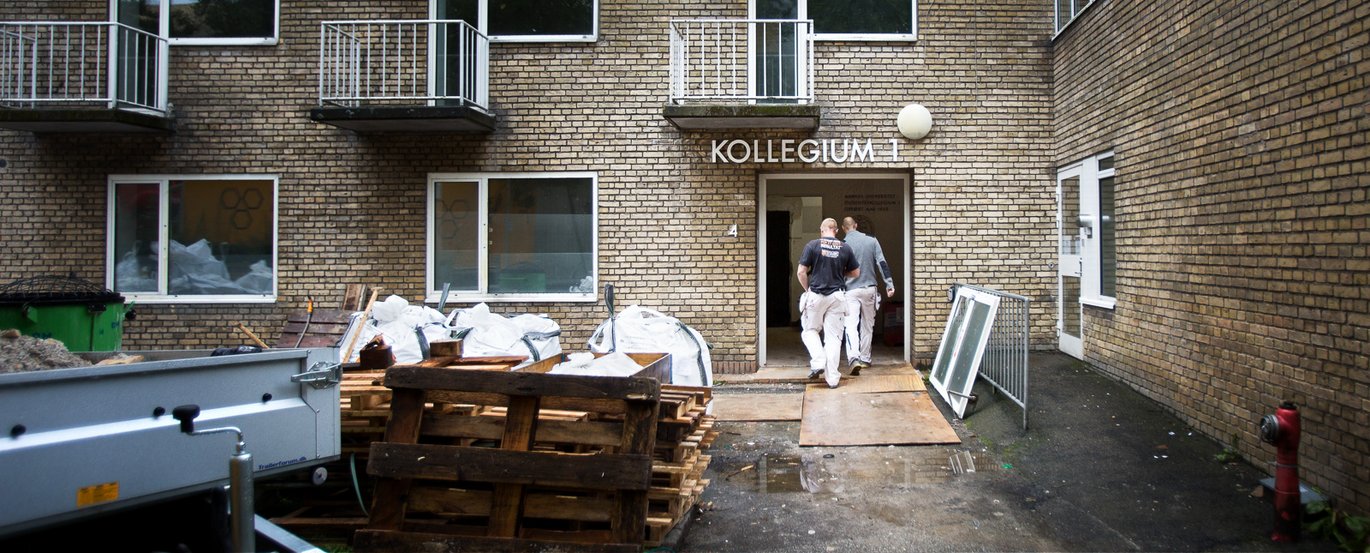
The first of August marked the beginning of the much-debated renovation work in AU's oldest hall of residence – Residence Hall 1 (Kollegium 1 in Danish, ed.). The building, which is from 1935, is getting a new roof, new windows, new electrical installations and new water pipes.
The residence hall board are the ones who have taken the decision to renovate Residence Hall 1. In connection with this, the residence hall board decided to convert the shared toilets and bathrooms in the corridors into extra rooms and instead equip all rooms in residence hall with own toilet and bathroom.
But this is where the students living in the hall say stop!
Several things give cause for concern, says Jakob Wadsager, who has been chair of the residence halls association since the autumn of 2016.
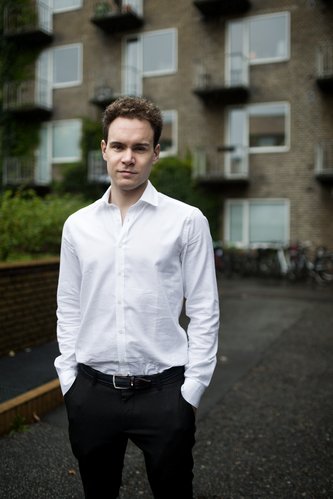
Chair of the residence halls association Jakob Wadsager.
"Will it mean increased rent for residents? Will it impact the special culture that there is in the resident halls, where we share toilets, bathrooms and kitchens? Will it will lead to noise in the rooms if your neighbour decides to take a shower at three in the morning?"
He continues:
"We can absolutely see the need to renovate the buildings and common areas, but we haven’t seen any empirical basis for why it’s necessary to have own bathroom and toilet in every room in order to future-proof the halls of residence."
Small rooms will become even smaller
For outsiders, it may seem strange that you’re so critical about the prospect of getting your own toilet and bathroom…
“I can understand that. However, personally I don’t experience problems with having to wait long to take a shower or use the toilet. I'm also worried about the issue of space in the rooms. They’re only 14 square metres now, and a bathroom and toilet will take up around four of those square metres. So there won’t be much space left for a bed and desk. And why change a model that the residents are very satisfied with?"
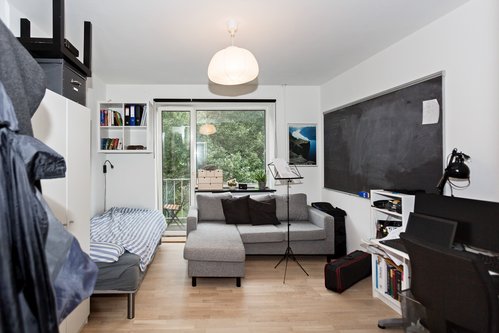
The room belonging to Jakob Wadsager.
If it was up to the residents, they would keep the existing model with shared kitchen, bathroom and toilet facilities, and renovate both the buildings themselves and the fixtures and fittings so they were modern and sustainable.
The sense of community lies as much in the kitchen
Anette W. Andersen is manager of the resident halls in the University Park and she is aware of the resident’s scepticism about the new type of rooms.
"The residents at the halls are very protective of their community. When you live in a residence hall, the sense of community on your floor and in the park as a whole is so strong that you don’t want to break with it just because you’re getting your own toilet and bathroom. Perhaps that’s what the residents here feel, but the sense of community is just as much tied to sharing the kitchen," she says.
Reduced influx to the residences in the University Park
The background for establishing bathroom and toilet in the rooms in Residence Hall 1 is that the board of the Student Halls of Residence in the University Park wish to ensure that the halls of residence will also offer attractive student housing for students in the future. At the same time, the Student Halls of Residence in the University Park have registered a decrease in the number of students wishing to live in the halls of residence in the University Park.
"Over the past couple of years, the influx to the Student Halls of Residence has declined. All the rooms are taken, but the waiting list has shortened. In 2015, the waiting time for a room in the halls of residence was fourteen months, but it’s fallen to around eleven months in 2016," says Andersen.
Must be attractive for students in the future
Earlier in the year, Erik Pagaard became director of Parkkollegierne A/S and therefore stopped as a member of the board of the Student Halls of Residence in the University Park. However, while a member of the board, he helped to take the decision to equip the rooms in Residence Hall 1 with toilet and bathroom.
"We have received unambiguous information from Student Housing Aarhus and various advisers telling us that resident halls without their own bathroom and toilet do not live up to what today's young people want. It’s seen as worse than modern standards," he says.
But the students in the resident halls point out that they are not dissatisfied with the existing model.
"That's correct, but the board’s perspective is wider than the five hundred students currently living in the Student Halls of Residence in the University Park. We have to look at the needs of students at AU more broadly, and what is best practice when it comes to these types of residence halls, because we need to offer a product that will also be in demand in two or three decades," says Pagaard.
In relation to the residents’ concerns about the size of the new rooms, Pagaard refers to a mock-up that was made of the new type of room to test whether there would be problems with lack of space.
"The tests showed that it’s possible. And we’ve done what we can to use as little space as possible, such as narrowing the hall area, but of course we can’t work magic when it comes to space."
Pilot project
The renovation of Residence Hall 1 is being carried out as a pilot project that will be evaluated before the renovation of the other halls of residence is begun, explains Pagaard.
"We’re going to let demand determine what happens with the new type of room before we decide what to do with the other halls of residence. It’s not certain that one solution is the right one for all nine halls of residence. But there is nothing wrong with establishing rooms with their own bathroom and toilet in Residence Hall 1, because there will always be demand for cheap accommodation with own bathroom and toilet and a central location."
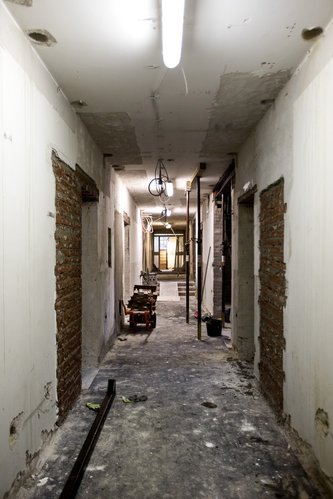
The tentative approach to the renovation plan worries the chair of the residence halls association.
"I’m worried that this is a premature and cheap solution rather than one where the project is properly thought through," says Wadsager.
"The project is certainly thought through," according to the manager of the halls of residence, who continues:
"But other wishes can become clear during such a process, and diversity is positive because it means we’ll have more diverse halls of residence."
Rent will increase by DKK 450 per month
Pagaard says that it has now been decided that the monthly rent for the newly refurbished rooms with their own toilet and bathroom in Residence Hall 1 will be DKK 450 higher than for rooms without own toilet and bathroom.
The residents in Residence Hall 1 have been rehoused in the other halls of residence in the University Park while the building is being renovated. The plan is for them to move back into their rooms after Easter next year – if they wish to.
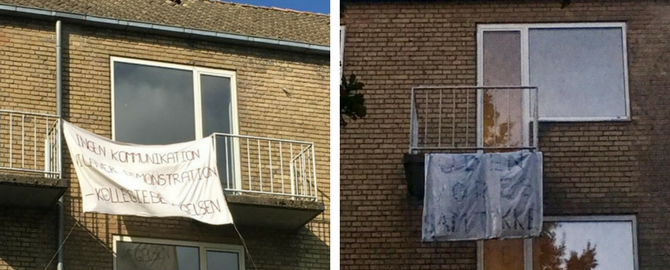
Students protesting against the renovation. 'No Communication, we demonstrate - the residence hall movement' og 'Without our consent', the banner says. Photo: Private
Facts
The halls of residence in the University Park were a self-governing institution until 2014, which is when they were transferred to Aarhus University Research Foundation as a gift. The board of the Student Halls of Residence in the University Park A/S have made the decision to initially renovate Residence Hall 1. The residence halls association is not represented on the board. The only student on the board is the chair of the Student Council Emil Outzen.
The residence halls association looks after the interests of its residents and works closely with the student accommodation office, which is headed by Anette W. Andersen. Dialogue between the residence halls association and the board is ensured via the liaison committee.
Translated by Peter Lambourne

